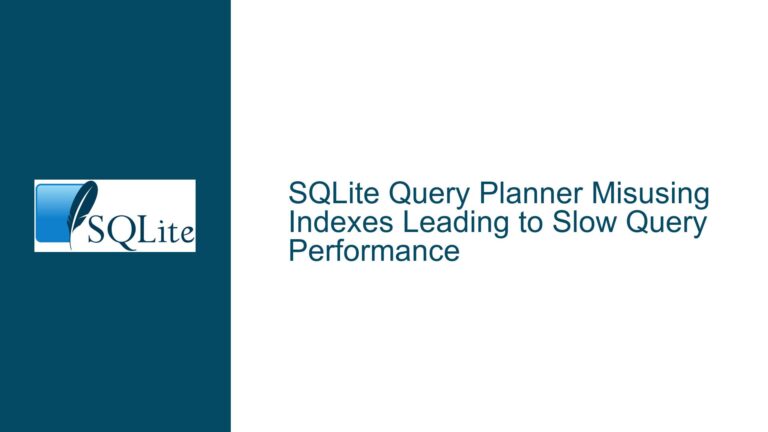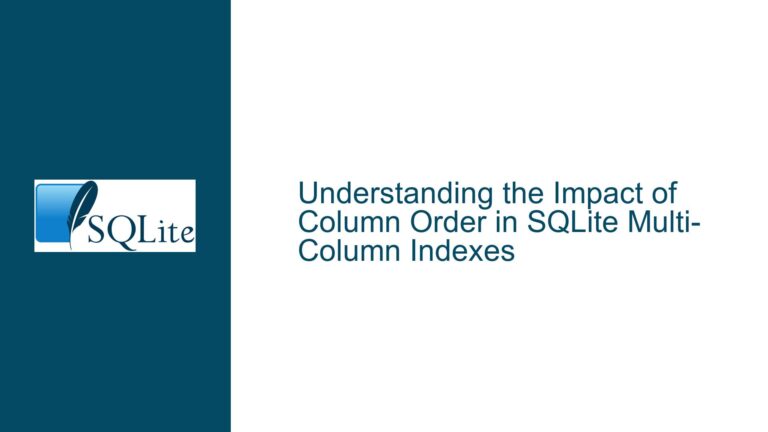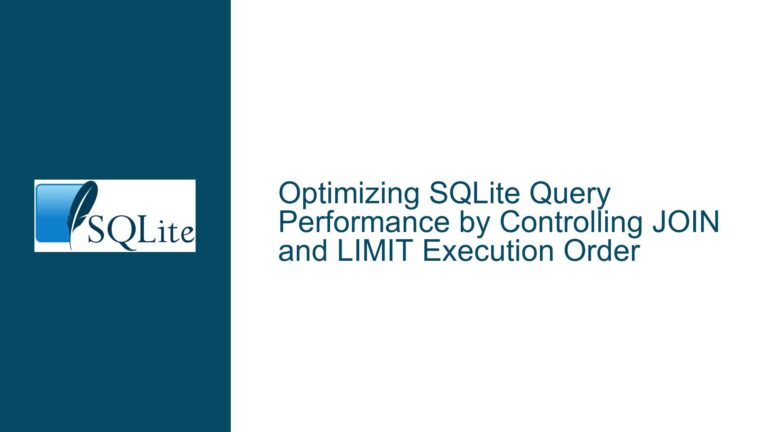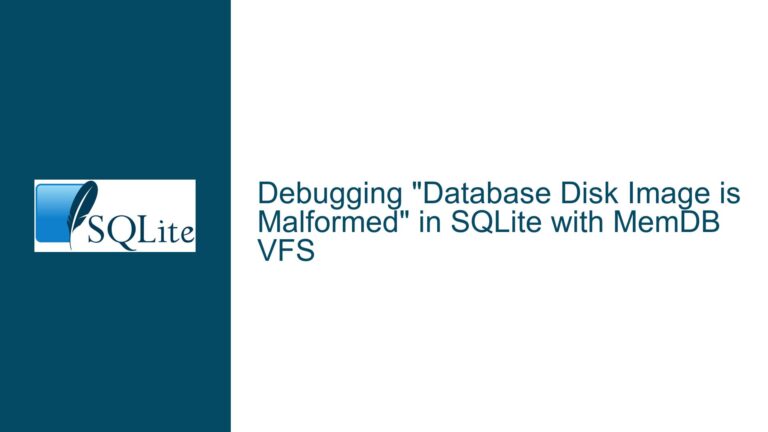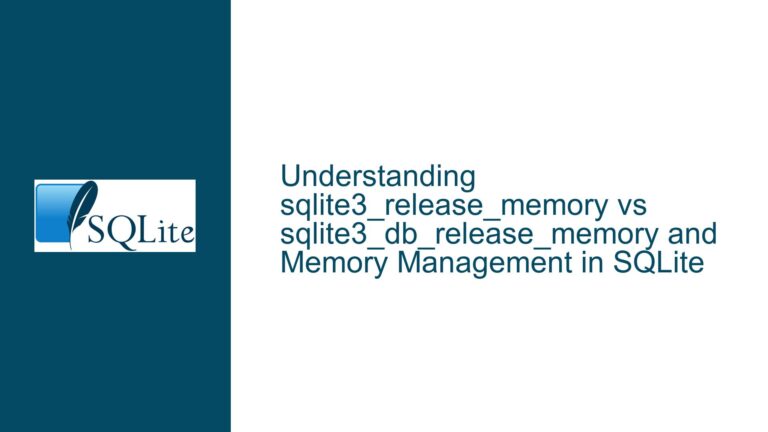SQLite MMAP: Buffer Pool vs. OS Memory Management Trade-offs
Understanding SQLite’s MMAP Implementation and Performance Implications
SQLite’s default configuration disables memory-mapped I/O (MMAP) due to documented concerns about reliability, portability, and performance. The core debate revolves around whether delegating file caching to the operating system via MMAP is superior to SQLite’s traditional buffer pool approach. Proponents of MMAP argue that it simplifies cache coordination across multiple processes accessing the same database, while critics highlight inherent limitations such as I/O stalls, atomicity challenges, and unpredictable memory pressure.
The CMU research paper cited in the discussion asserts that custom buffer pools managed by the database engine outperform MMAP in single-process or tightly controlled multi-process environments. Buffer pools allow fine-grained control over cache eviction policies, dirty page management, and I/O scheduling. However, SQLite operates in diverse environments where connections may span multiple processes without centralized coordination. In such cases, relying on the OS to manage memory via MMAP avoids redundant caching and ensures consistency across processes. This trade-off is particularly relevant for applications where database files are accessed concurrently by independent processes (e.g., web servers with forked workers).
A critical nuance is SQLite’s use of the mmap_size pragma to configure MMAP. When enabled, SQLite maps database files into the process address space, allowing the OS to handle page caching. This shifts responsibility for cache coherence from SQLite’s buffer pool to the kernel’s virtual memory subsystem. While this reduces complexity in multi-process scenarios, it introduces dependencies on OS-specific behaviors. For instance, Linux’s page cache and swap management directly influence performance, whereas Windows’ handling of mapped files may differ substantially.
The discussion also references Linux’s Multi-Generational Least Recently Used (MGLRU) feature introduced in kernel 6.1. MGLRU improves page reclaim efficiency by categorizing pages into generations based on access recency, which mitigates memory overcommit issues common in MMAP-heavy workloads. This OS-level advancement partially addresses historical criticisms of MMAP but does not eliminate fundamental architectural trade-offs.
Root Causes of MMAP-Related Performance and Coordination Challenges
The primary conflict arises from competing strategies for managing cached database pages: application-managed buffer pools versus OS-managed MMAP. Each approach has distinct failure modes and optimization boundaries.
1. Lack of Cross-Process Cache Coordination
SQLite connections in separate processes cannot directly share buffer pool state. Without MMAP, each process maintains its own cache, leading to redundant memory usage and potential inconsistencies. For example, Process A may modify a page in its buffer pool while Process B holds an outdated version. Write-ahead logging (WAL) mitigates this but does not eliminate the need for cache synchronization. MMAP bypasses this problem by leveraging the OS’s unified page cache, ensuring all processes see the same underlying pages. However, this comes at the cost of ceding control over cache eviction and prefetching to the OS, which may not align with database access patterns.
2. MMAP’s Dependency on Kernel Page Cache
When MMAP is active, SQLite relies on the kernel to decide which pages remain in memory. This can lead to suboptimal behavior when the kernel evicts hot database pages to accommodate other system activities. The CMU paper demonstrates that buffer pools outperform MMAP under sustained high-pressure workloads because they prioritize database-specific access patterns. For instance, a buffer pool might retain frequently accessed index pages, while the kernel’s LRU-based eviction could discard them during memory pressure.
3. I/O Stalls and Page Fault Overhead
MMAP transforms database reads into page faults, which are serviced by the kernel. While this simplifies application logic, it introduces latency spikes when fault handling intersects with large scans or random access patterns. Buffer pools allow asynchronous I/O scheduling, where the database engine prefetches pages in advance of queries. MMAP’s reactive fault model struggles to hide I/O latency in comparable scenarios.
4. Atomicity and Write Amplification
SQLite’s write-ahead logging (WAL) mode interacts differently with MMAP. When a process modifies a MMAP-ed page, the kernel propagates changes directly to the page cache, which may flush to disk asynchronously. This creates a risk of partial writes if the system crashes before dirty pages are persisted. Buffer pools provide stricter control via explicit writeback mechanisms, aligning with SQLite’s ACID guarantees.
5. Memory Overcommit and OOM Risks
MMAP can overcommit physical memory by mapping files larger than available RAM. The kernel handles this via swap and page reclaim, but aggressive overcommitment risks out-of-memory (OOM) conditions. Pre-Linux 6.1 kernels suffered from inefficient page reclaim algorithms, exacerbating this issue. MGLRU improves fairness in page eviction, reducing the likelihood of pathological thrashing.
Optimizing SQLite MMAP Configuration and Mitigating Limitations
To resolve MMAP-related issues, administrators must balance SQLite’s pragmas, OS configuration, and workload characteristics. Below is a structured approach to diagnosing and addressing common pitfalls.
1. Diagnosing MMAP Suitability
Begin by profiling the workload using SQLite’s sqlite3_status() API or diagnostic pragmas like cache_stats. Key metrics include page cache hit rate, I/O wait time, and writeback volume. Compare these metrics between MMAP and buffer pool modes using the mmap_size pragma to toggle MMAP. Workloads dominated by random reads often benefit from MMAP, while write-heavy or sequential access patterns may perform better with buffer pools.
2. Configuring MMAP Size
Use PRAGMA mmap_size=N to limit the mapped region. Start conservatively (e.g., 25% of available RAM) and incrementally increase while monitoring system-wide memory pressure. On Linux, tools like smem and vmstat help track resident memory and swap usage. Avoid setting mmap_size to the entire database size unless physical RAM exceeds the working set.
3. Leveraging OS-Specific Optimizations
On Linux 6.1+, enable MGLRU by adding vm.mglru_enabled=1 to sysctl.conf. This improves page reclaim fairness, reducing the risk of premature eviction of database pages. Adjust the swappiness parameter (vm.swappiness) to 10-20 to prioritize keeping SQLite pages in memory. For Windows, ensure the system is configured for background writeback (via registry settings) to minimize write stalls.
4. Combining WAL Mode with MMAP
WAL mode reduces contention between readers and writers but requires careful tuning with MMAP. Set the wal_autocheckpoint pragma to a value that aligns with WAL file growth patterns. Monitor the sqlite3_wal_checkpoint() frequency to ensure WAL files do not grow unbounded, which would amplify MMAP’s memory footprint.
5. Fallback Strategies for High-Pressure Scenarios
If MMAP causes instability under memory pressure, revert to buffer pools and increase the page_cache size. Use PRAGMA cache_size=-kibibytes to allocate a fixed-size buffer pool. For multi-process setups, consider a dedicated daemon process that centralizes cache management and serves other processes via IPC.
6. Monitoring and Profiling Tools
Deploy eBPF-based tools like biolatency and mmapstats to trace page fault latency and MMAP I/O patterns. On Linux, perf record can sample page fault handlers to identify hot paths. For long-running processes, periodically log SQLite’s internal stats (e.g., sqlite3_db_status()) to detect cache efficiency degradation.
7. Alternative Architectures for Extreme Workloads
When MMAP and buffer pools both underperform, offload caching to a user-space filesystem like SQLite’s VFS shim or a dedicated caching layer (e.g., Redis for hot rows). For cloud deployments, consider using a RAM-backed filesystem (tmpfs) with periodic snapshots to durable storage.
By systematically evaluating these dimensions, developers can tailor SQLite’s memory management strategy to their specific environment, avoiding the one-size-fits-all pitfalls highlighted in the original discussion.

